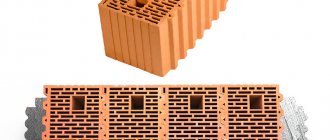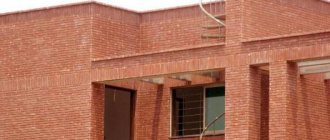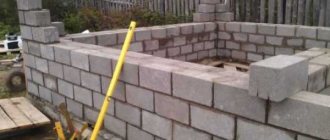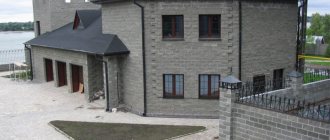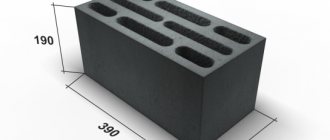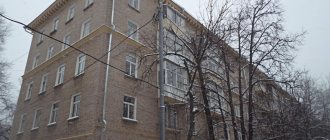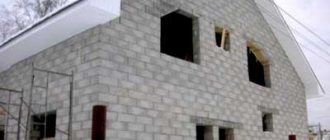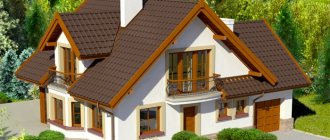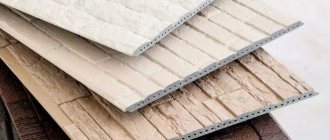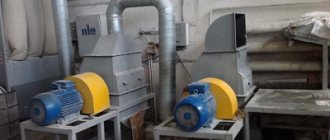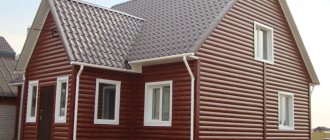During the renovation, I erected several partitions from ceramic blocks (more details in the article “Partitions from ceramic blocks in an apartment: construction and plastering” ) and then even demolished one of them. Before starting work, I attended a seminar at one of the manufacturers. Therefore, I have a certain opinion about this material, which I want to share. Perhaps this information will help someone make a choice.
Ceramic block 80 millimeters thick
This article discusses ceramic blocks from the point of view of their use for the construction of partitions in an apartment.
Next - about the pros, cons, reasons for demolishing the new partition and why I’m unlikely to use ceramic blocks in the apartment again.
Characteristics and disadvantages of ceramic blocks
To make ceramic blocks, the same red clay is used as for ordinary masonry bricks.
Their main difference is in size and raw materials. To produce ceramic blocks, fine sawdust is added to the clay. After the green blocks are shaped, they are fired. As a result of this operation, the sawdust burns out, and the clay becomes more like stone. At the end of the processing, a durable wall block with good heat-insulating properties is obtained. The weight of the ceramic block is significantly reduced due to the formation of slot voids.
The figure can reach up to 50%. The dimensions of the ceramic block are much larger than those of ordinary bricks, so the labor intensity of the work is reduced several times.
Advantages of using ceramic blocks as partitions
Strength
M75 – M100, which means that the material can withstand a load of 75-100 kg/cm2). This allows you to attach almost any objects to the wall (batteries, pipes, interior elements, kitchen units, boiler, etc.) depending on the type of fastening - you can read more about all possible options in this article.
Large block format
Increases the speed of construction of partitions several times (which allows you to save on labor costs), and saves mortar.
Soundproofing
From 50 dB, which will ensure silence when there are people in other rooms and keep any conversation private.
Ecology and hypoallergenic
One of the main advantages of this material. Simple manufacturing technology, natural ingredients: clay, sawdust, water.
Natural regulation of air temperature
Due to the property of the material to accumulate heat and distribute it evenly.
High fire resistance
120/I90, where E120 means the duration of 120 minutes during which the wall of partition blocks will maintain its structure in an open fire, and I90 means the time (90 minutes) during which the wall will protect other areas from heat penetration.
Types and sizes of ceramic blocks
According to GOST sizes, ceramic blocks are as follows:
Length – 250, 380, 398 or 510 mm;
Width – 180, 250 or 255 mm;
Height – 140, 188 or 219 mm.
The minimum size of a stone block is 250x120x140 (i.e. 2.1 NF - 2.1 from the size of a standard brick 250x120x65). In addition to the 14 standard sizes specified in the standards, some manufacturers produce blocks with other dimensions. But it is best to buy GOST products. They simplify the calculation of wall thickness and allow you to use ordinary bricks side by side in masonry without any problems.
The outer walls of a ceramic block are always larger than 8 mm. The thicker they are, the denser and stronger the stone. However, as the density increases, the thermal conductivity of a ceramic block increases. Here you need to look for a middle ground. It all depends on how many storeys the house will be and whether it is planned to insulate its external walls.
Table of characteristics of a ceramic block of the Braer brand
| Characteristic | Format | ||||
| 10.7NF | 14.3NF | 7.1NF | 5.2NF | 12.4NF | |
| Length, mm | 380 | 510 | 510 | 380 | 440 |
| Width, mm | 250 | 250 | 130 | 130 | 250 |
| Height, mm | 219 | 219 | 219 | 219 | 219 |
| Weight, kg | 17 | 24 | 13 | 9,5 | 19,4 |
| Brand, kgf/cm2 | M 75-125 | M 75-125 | M 75-125 | M 75-150 | M 100-125 |
| Frost resistance, cycle | 50 | 50 | 50 | 50 | 50 |
| Water absorption,% | 11-14 | 11-14 | 11-14 | 9-11 | 11-13 |
| Quantity on pallet, pcs. | 60 | 40 | 72 | 108 | 40 |
| Loading rate per vehicle 20 tons, pcs. | 1080 | 800 | 1440 | 2160 | 960 |
| Emptiness, % | 59 | 59 | 49 | 49 | 59 |
| Thermal conductivity, (W/m °C) | 0,14 | 0,14 | 0,166 | 0,166 | 0,139 |
Like standard brick, its larger counterpart is divided into ordinary and facing products. The former are used in the construction of internal partitions, as well as external wall structures, which will then be covered with facade finishing. The latter have a polished side and are intended for laying exclusively external walls of houses. They no longer need additional decor on top.
Major manufacturers of ceramic porous blocks
Warm ceramics are a guarantee of quality and reliability. In addition to the fact that the Wienerberger ceramic block allows you to build ready-made walls, fakes are widespread on the construction market. The brick manufacturer Wienerberger takes a very careful approach to the production of its products. Porous stone is made from environmentally friendly raw materials of natural origin: clays and loams, with the addition of sand and porous agents - sawdust, shavings, rice husks.
The manufacturer Gzhel Brick Factory has existed for more than seventy years. The Gzhel plant produces high-quality wall ceramics at low prices, due to the fact that the plant is located near clay deposits.
| Name of characteristic (indicator) | Meaning and comments |
| Thermal conductivity | 0,1-0,2 |
| Frost resistance | From 50 cycles |
| Wall thickness | From 0.6 m |
| Water absorption | No more than 10% |
| Strength grade | 75 |
Advantages and disadvantages of porous blocks for building a house
Despite the contradictory opinions, ceramic block is a high-quality and convenient material for construction. Among the key advantages are the following features:
Complete environmental safety - the raw materials do not contain chemically active or toxic components.
High rates of thermal insulation of premises.
Excellent level of street noise absorption.
Minimal structural weight - does not cause inconvenience during installation.
Good load resistance.
Fire safety - does not burn and does not support the spread of fire.
High speed of construction of wall structures.
No reinforced foundation required.
Of course, there are some shortcomings that require detailed consideration. Here you can note the following nuances:
Price - the material is considered expensive, so despite the high technical characteristics, many prefer a lower quality, but more budget option.
Strength – the end parts are not resistant to dynamic loads.
Fragility - if transportation rules are not followed, the percentage of broken blocks will be simply terrifying.
Installation - non-compliance with installation technology nullifies all the advantages of the ceramic block.
In addition, the material can cause inconvenience in operation. In particular, dowels and screws do not hold in a wall made of ceramic blocks; only anchor bolts are suitable. It will not work to split a ceramic block by tapping it with a hammer, like a brick: you only need to cut it with a grinder.
What to choose for construction - brick or ceramic block?
What to choose for construction - brick or ceramic block? To construct any building, it must have at least four walls. Making a choice nowadays is quite difficult, because there are so many types of building materials - from many types of wood to ultra-modern blocks. This article will compare materials such as ceramic block and brick. In order to choose the right material, you need to study the characteristics, price, and advantages in detail. First, let's look at brick
. This is a stone material that undergoes processing, consisting of baked clay, cement, etc. It comes in two varieties: the so-called silicate and ceramic. They differ in moisture resistance, temperature stability and price. Besides them, there are several more subspecies, but they all differ only in external qualities.
Until the second half of the 19th century, the production of clay bricks was manual. The bricks were molded into rectangles by hand using molds; the possibility of drying the molded bricks was only in the summer; firing took place in temporary floor ovens. In the mid-19th century, the ring kiln was invented and subsequently widely used, which revolutionized production technology. At the end of the 19th century, special drying machines also appeared that made it possible to create bricks all year round. Almost at the same time, clay-processing machines and tools appeared. In the 21st century, approximately 80% of brick production is year-round, and some large automated production plants have increased production to over 200 million units per year.
According to some experts in this field, brick construction has gained popularity due to centuries of experience rather than quality. The characteristics of this material are outlined below:
— good resistance to external factors; — sound insulation; — environmental safety; — brick walls are very durable.
Brick has the following disadvantages.
1) Brick walls absorb moisture very well, which can cause dampness to form.
2) Brick is a rather heavy material for construction.
3) It is also quite expensive material.
In many European countries, when deciding what material to build the walls of a house from, they choose the so-called ceramic block. It is environmentally friendly, a multi-story house can be built from it, and it will last for more than 150 years! Ceramic blocks are joined using a tongue-and-groove connection. Advantages of ceramic block
— There is no need to use the solution in vertical joints, which allows it to be used more rationally. - Cold resistance. — Good sound insulation, heat resistance. — When a house made of ceramic block is used for more than 150 years, it does not lose its thermal characteristics.
Ceramic block, oddly enough, also has disadvantages.
— Quite a high price.
— Finding a craftsman to build ceramic block walls is quite difficult (especially in Russia), because the material is new.
— This material is very fragile.
So, we compared these two building materials, both have both advantages and disadvantages, and it’s up to you to decide what to choose - traditional brick or modern ceramic block!
What type of brick is best to use for the construction of interior partitions?
A brick wall is considered more durable than the above materials. Internal partitions are usually laid in half a brick. Their thickness, if plastered on both sides, is approximately 160 mm. Massive paintings and heavy shelves can be hung on solid brick walls.
For the construction of internal walls, the following types of bricks are used:
- Ceramic and silicate. Sand-lime brick has low moisture resistance, so it is not recommended for use in rooms with high humidity.
- Full and hollow. For use under high loads and in wet rooms, it is recommended to use solid ceramic bricks.
Conditions for installing partitions in an apartment
Partitions made from blocks are allowed to be installed in living spaces, but special requirements apply to this work. For example, you cannot increase the kitchen area at the expense of the bathroom. It is not allowed to increase the living space at the expense of the kitchen and bathroom. If it was decided to move the bathroom, it should not be located above the kitchen of the neighbors below. The kitchen in the apartment should not end up in the living space after redevelopment.
When dismantling partitions, a common mistake is often made, which leads to the combination of a kitchen with a living space, the first of which has a gas stove. A partition cannot be erected if there is a desire to delimit space in a room with one light source. A new wall in an apartment cannot be built if heavy blocks without its own foundation are used. In this case we are talking about blocks with a density of D600 and higher. An alternative solution is a 10-cm wall made of foam block or a plasterboard partition built using frame technology.
Dismantling partitions made of ceramic blocks.
Removing the partition was not as easy as I thought. The construction turned out to be very durable. Dismantling took almost an hour with a hammer drill, despite the area being only 4.5 square meters. It would be impossible to do the job without a hammer drill.
After dismantling, a partition was erected in the same place on a plasterboard frame. Sound transmission through it is much less and the load on the floor is also much less. Therefore, I don’t regret at all what I did.
Advantages and disadvantages of ceramic blocks
Statistics show that in Western European countries, from a third to a half of all low-rise buildings are built using building ceramics. In our country, this figure is still less than 10%, but tends to grow steadily. This is facilitated by a number of positive qualities:
- The high thermal insulation qualities of the material make it possible to build walls from it without the use of additional insulation. Thus, a wall with a thickness of 44–51 cm corresponds in its heat-saving properties to SNiP standards for such regions as the Baltic States, the Volga region, the Central Black Earth Region, not to mention the more southern regions. This aspect makes construction from ceramic porous materials more financially profitable.
- Simplicity and speed of installation. Due to the large dimensions of the blocks, building a wall from them will take much less time than laying standard bricks. In addition to saving time, this also provides significant savings in masonry mortar.
- Durability of use. The service life of the wall guaranteed by the manufacturer is about 50 years, which is not inferior to similar indicators for concrete or sand-lime brick. It should be borne in mind that in reality this period can be much more than half a century.
- Low weight. Due to the presence of internal voids, ceramic blocks have a much lower density than solid brick or concrete. This makes it possible to use lightweight foundation options in construction - columnar and pile, which again leads to significant savings in building material and time.
- Excellent sound insulation. Due to their porosity, the blocks not only have excellent thermal insulation properties, but also good noise absorption.
- Fire resistance. Since clay is a completely non-flammable material, a wall made of ceramic blocks can withstand the spread of fire.
- Unlike wooden building materials, ceramics do not shrink, so interior decoration can begin immediately after construction is completed.
- Vapor permeability. Ceramic blocks do not interfere with the free exchange of gases between the interior of the building and the outside world. As a result, a comfortable microclimate is created in the premises and the formation of fungus and mold on the internal surfaces of the walls is prevented. For more information about construction using ceramic blocks, watch this video:
Ceramic blocks are fragile, so they must be handled with care during loading and transportation.
Like all other building materials, ceramic blocks also have their drawbacks, which must be taken into account when designing a building and carrying out construction work.
Due to their structure with internal voids, ceramic blocks are not resistant to shock loads, so care must be taken when transporting and constructing them. In addition, the presence of pores determines their high hygroscopicity.
To avoid excessive moisture in the blocks and their subsequent destruction when moisture freezes, moisture should not be allowed to penetrate into the internal cavities during construction.
European standard sizes of porous stone
Below are the parameters most often found on the ceramic bricks market, since in addition to those specified by GOST 530-2012, there are also European standards.
Table 3: European standard sizes for load-bearing walls
| Length | Width | Height | Equivalent, NF |
| 248 | 440 | 238 | 13,32 |
| 250 | 440 | 219 | 12,35 |
| 248 | 380 | 238 | 11,5 |
| 248 | 300 | 238 | 9,08 |
| 250 | 450 | 238 | 13,6 |
| 250 | 300 | 238 | 11,4 |
| 375 | 300 | 238 | 9,1 |
| 250 | 380 | 238 | 11,4 |
For European manufacturers, the working height of the ceramic block is usually standard and is 238–239 mm . With these ceramic products it is convenient to use flexible connections to strengthen and stabilize partitions.
Table 4: Parameters of ceramic blocks for partitions
| Length | Width | Height | Equivalent, NF |
| 500 | 115 | 238 | 7 |
| 380 | 100 | 238 | 4,6 |
| 380 | 120 | 238 | 5,2 |
| 498 | 80 | 239 | 4,8 |
| 498 | 115 | 238 | 6,9 |
The height of the blocks of European companies according to the standard is a minimum of 80 mm for building cladding, the maximum length of the product is 510 mm for load-bearing structures. In this case, the weight of the stone should be less than 20 kg. The specific format of individual blocks depends on the purpose and type:
Non-standard parameters of ceramic blocks in mm and their markings:
- 240*115*71 (NF);
- 240*115*52 (DF) ;
- 240*115*113 (2DF).
Such formats are used quite rarely in the construction of buildings in the CIS, although they do occur.
Gas silicate blocks: cheap, and therefore popular
Let's move on to the popularly loved gas silicate blocks. Over the years, this building material has not lost its popularity. For the construction of interior partitions, slabs 10 centimeters thick are optimally suited.
Alexander: These blocks are quite light. If you have to climb the stairs to the 9th floor, you will suffer, of course, but not as much as with the same cast. However, this is not a problem at the dacha. Such blocks are easy to saw, erected quickly, and channels for routing wires can be cut without problems. But the main reason for their popularity is their low price.
Gas silicate also has plenty of disadvantages. Sound insulation is not ideal: the walls dampen conversations and the sound of a running TV, but they still transmit vibration. Despite the relatively light weight of the blocks, such a partition cannot be placed on the screed; it is necessary to cut the fine to the floor slab and erect a partition from it. Let's not forget about the increased level of water absorption. Also, the use of gas silicate entails additional costs due to the need to apply plaster. Residents may have difficulty securing heavy pieces of furniture.
Maxim: By the way, here’s a question. I once hung curtain rods using self-tapping screws, and after a month they began to sag slightly. The problem was solved by selecting the right dowel, but how to attach something heavier to gas silicate?
Taras: Special chemical anchors have been invented for this. A cylindrical hole is drilled and shaped into a cone with an expansion in depth. The cavity is filled with a chemically active adhesive mass, and an anchor is inserted. When hardened, the composition forms a monolithic connection between the wall material and the anchor.
Maxim: What is the optimal thickness for interior partitions made of gas silicate? When I built the house, the design included blocks 15 centimeters thick with a ceiling height of 2.8 meters. The designer said it’s safer and stronger this way. Then I look on the Internet: everyone has septums of 10 centimeters. It turns out that I lost in price, but what did I win in then?
Alexander: “Ten” works normally as a partition at a height of up to 3 meters; if the wall is higher, I would recommend 15 centimeters. An additional 5 centimeters has almost no effect on sound insulation; you won’t feel much of a difference. Otherwise, a thick block will only eat up a certain percentage of the total area. Do you need it?
Taras: I think the difference will be visible only in the estimate. Well, you can brag to your neighbor if he doesn’t understand these matters.
WIENERBERGER carries out technical supervision at sites
Question for the professionals. What material is best to use for interior partitions in an apartment? The walls are complex, straight + radius. Drywall is absolutely not acceptable. Sliding and cashless doors are expected, on one of the walls there will be a plasma panel and a hanging cabinet for a sink 1-1.2 m wide
How problem-free will a 100mm foam block be (in terms of strength and hanging heavy objects), or is it better to consider other options? If yes, which ones?
It can only be securely fixed into a foam block using a chemical anchor. In principle, this is not a problem. The material is undoubtedly good, but very hygroscopic. There is no place for foam blocks in the bathroom. It’s good to use moisture-resistant PGP in the bathroom, but even chemical anchors won’t hold in them. You can hang something heavy on them only with a through fastening. In terms of strength, brick certainly rules, but there is a lot of hassle with it, which is not always justified. Personally, I am a supporter of “plasterboard” partitions (by the way, not only gypsum boards can be sheathed with them). GCRs are usually not liked by those who have not seen a correctly installed partition using Knauf technology and materials.
Conclusion
When using any building material, much depends on its original quality (on the quality of a particular production), on compliance with the requirements for its storage, transportation and technology for using this material. Any good and expensive material can be turned into waste by violating the technique and technology of its use.
Construction from large-format ceramic blocks using warm mortar is a real way to get an energy-efficient, comfortable home for a reasonable price and in a short time.
In the profile thread on the forum, you can consult with self-builders and experts on the topic of choosing porous ceramic blocks. One of the previous materials contains façade finishing options for different tastes and budgets. In the video, a mason shares the nuances of working with warm ceramics.
What is meant by the dimensions of a ceramic block?
The properties and dimensions of ceramic blocks are specified by law in the document GOST 530-2012 “Ceramic brick and stone”.
The dimensions of the stone are:
- width;
- height;
- the thickness of a separate product that is used for laying walls.
The width is measured along the working surface with grooves and determines the thickness of the finished wall, laid in one row of ceramic blocks. Length is measured along the longest side of the stone, and thickness is the height of the product.
The thickness of warm ceramic masonry is determined by the width of an individual ceramic block.
